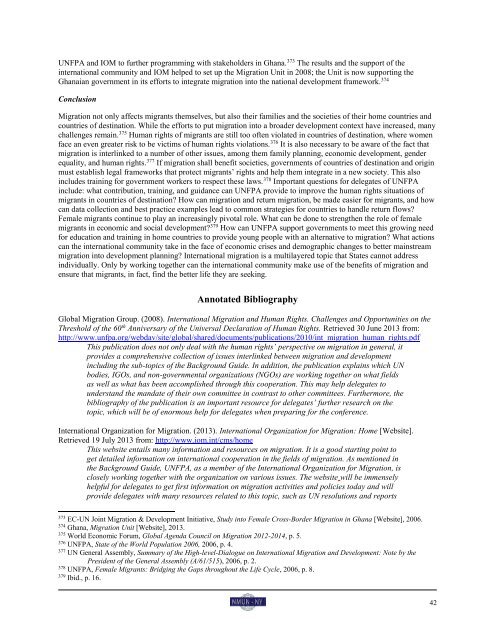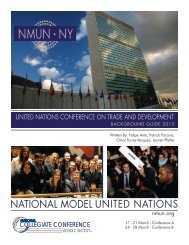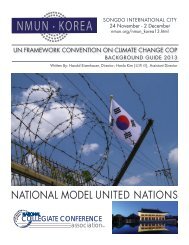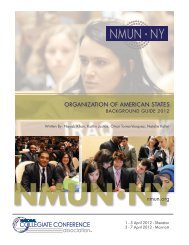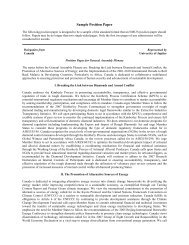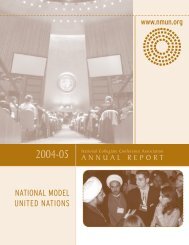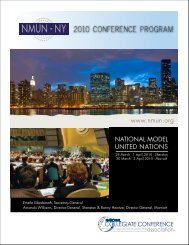UNFPA Background Guide - National Model United Nations
UNFPA Background Guide - National Model United Nations
UNFPA Background Guide - National Model United Nations
You also want an ePaper? Increase the reach of your titles
YUMPU automatically turns print PDFs into web optimized ePapers that Google loves.
<strong>UNFPA</strong> and IOM to further programming with stakeholders in Ghana. 373 The results and the support of the<br />
international community and IOM helped to set up the Migration Unit in 2008; the Unit is now supporting the<br />
Ghanaian government in its efforts to integrate migration into the national development framework. 374<br />
Conclusion<br />
Migration not only affects migrants themselves, but also their families and the societies of their home countries and<br />
countries of destination. While the efforts to put migration into a broader development context have increased, many<br />
challenges remain. 375 Human rights of migrants are still too often violated in countries of destination, where women<br />
face an even greater risk to be victims of human rights violations. 376 It is also necessary to be aware of the fact that<br />
migration is interlinked to a number of other issues, among them family planning, economic development, gender<br />
equality, and human rights. 377 If migration shall benefit societies, governments of countries of destination and origin<br />
must establish legal frameworks that protect migrants’ rights and help them integrate in a new society. This also<br />
includes training for government workers to respect these laws. 378 Important questions for delegates of <strong>UNFPA</strong><br />
include: what contribution, training, and guidance can <strong>UNFPA</strong> provide to improve the human rights situations of<br />
migrants in countries of destination? How can migration and return migration, be made easier for migrants, and how<br />
can data collection and best practice examples lead to common strategies for countries to handle return flows?<br />
Female migrants continue to play an increasingly pivotal role. What can be done to strengthen the role of female<br />
migrants in economic and social development? 379 How can <strong>UNFPA</strong> support governments to meet this growing need<br />
for education and training in home countries to provide young people with an alternative to migration? What actions<br />
can the international community take in the face of economic crises and demographic changes to better mainstream<br />
migration into development planning? International migration is a multilayered topic that States cannot address<br />
individually. Only by working together can the international community make use of the benefits of migration and<br />
ensure that migrants, in fact, find the better life they are seeking.<br />
Annotated Bibliography<br />
Global Migration Group. (2008). International Migration and Human Rights. Challenges and Opportunities on the<br />
Threshold of the 60 th Anniversary of the Universal Declaration of Human Rights. Retrieved 30 June 2013 from:<br />
http://www.unfpa.org/webdav/site/global/shared/documents/publications/2010/int_migration_human_rights.pdf<br />
This publication does not only deal with the human rights’ perspective on migration in general, it<br />
provides a comprehensive collection of issues interlinked between migration and development<br />
including the sub-topics of the <strong>Background</strong> <strong>Guide</strong>. In addition, the publication explains which UN<br />
bodies, IGOs, and non-governmental organizations (NGOs) are working together on what fields<br />
as well as what has been accomplished through this cooperation. This may help delegates to<br />
understand the mandate of their own committee in contrast to other committees. Furthermore, the<br />
bibliography of the publication is an important resource for delegates’ further research on the<br />
topic, which will be of enormous help for delegates when preparing for the conference.<br />
International Organization for Migration. (2013). International Organization for Migration: Home [Website].<br />
Retrieved 19 July 2013 from: http://www.iom.int/cms/home<br />
This website entails many information and resources on migration. It is a good starting point to<br />
get detailed information on international cooperation in the fields of migration. As mentioned in<br />
the <strong>Background</strong> <strong>Guide</strong>, <strong>UNFPA</strong>, as a member of the International Organization for Migration, is<br />
closely working together with the organization on various issues. The website will be immensely<br />
helpful for delegates to get first information on migration activities and policies today and will<br />
provide delegates with many resources related to this topic, such as UN resolutions and reports<br />
373<br />
EC-UN Joint Migration & Development Initiative, Study into Female Cross-Border Migration in Ghana [Website], 2006.<br />
374<br />
Ghana, Migration Unit [Website], 2013.<br />
375<br />
World Economic Forum, Global Agenda Council on Migration 2012-2014, p. 5.<br />
376<br />
<strong>UNFPA</strong>, State of the World Population 2006, 2006, p. 4.<br />
377<br />
UN General Assembly, Summary of the High-level-Dialogue on International Migration and Development: Note by the<br />
President of the General Assembly (A/61/515), 2006, p. 2.<br />
378<br />
<strong>UNFPA</strong>, Female Migrants: Bridging the Gaps throughout the Life Cycle, 2006, p. 8.<br />
379<br />
Ibid., p. 16.<br />
42


